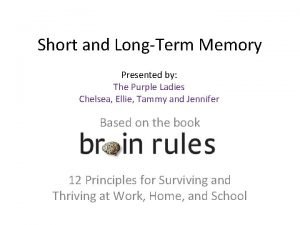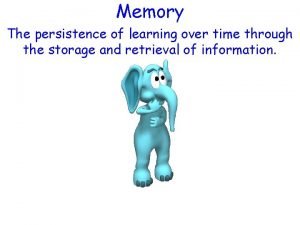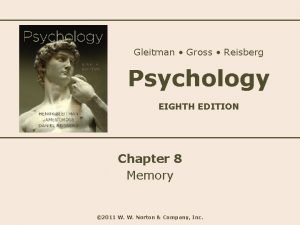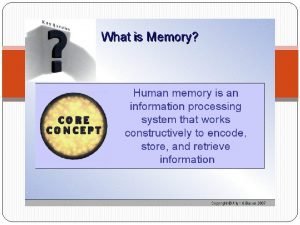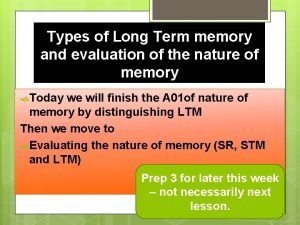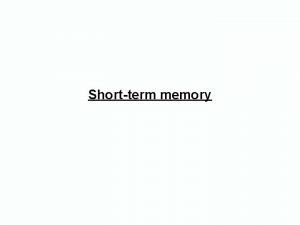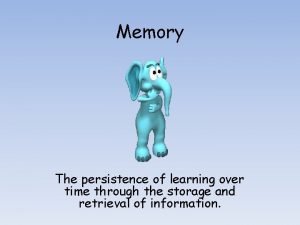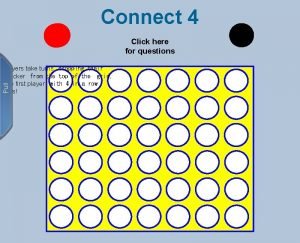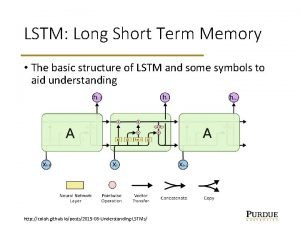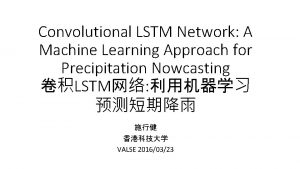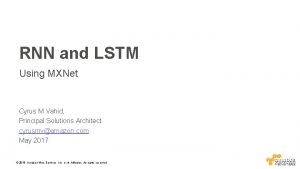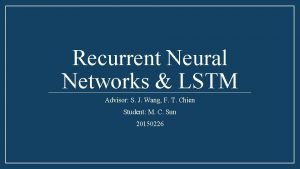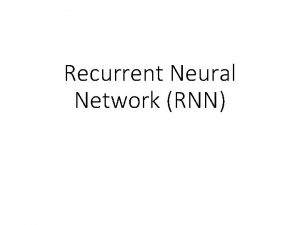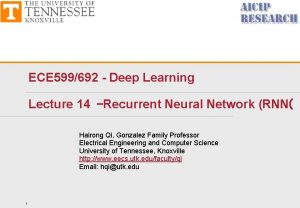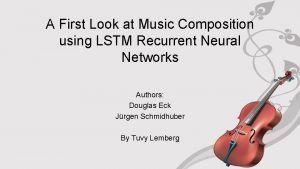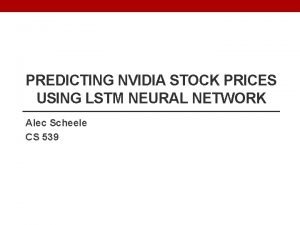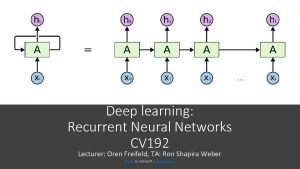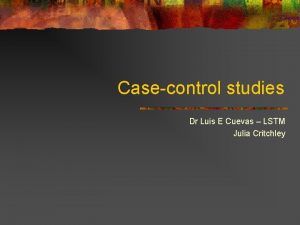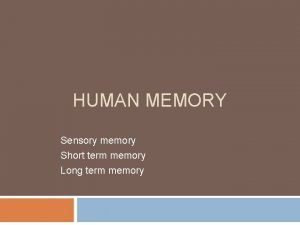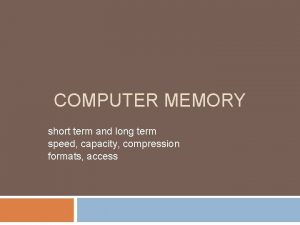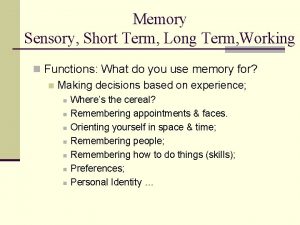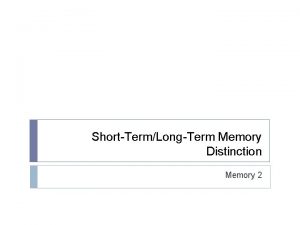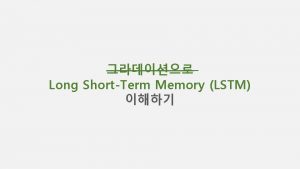LSTM Long Short Term Memory Image Processing Seminar























































- Slides: 55

LSTM Long Short Term Memory Image Processing Seminar Roy Franco IDC 2018

Agenda ● Vanishing / Exploding Gradient ○ ○ Backpropagation Recap ■ Chain Rule Refresher ■ Activation term in gradient calculation ■ Weights term in gradient calculation RNN gradient flow ● LSTM - Long Short Term memory ○ ○ ● ● Architecture Gradient flow GRUs Deep RNNs Attention Applications


Vanishing/Exploding Gradient

Back. Propagation Recap | Chain Rule Refresher

Back. Propagation Recap | Applying the chain rule Consider the following single neuron network

Back. Propagation Recap | Applying the chain rule

Back. Propagation Recap | Applying the chain rule

Back. Propagation Recap | Applying the chain rule

Back. Propagation Recap | Applying the chain rule what if our network had 10 hidden layers. What is the derivative of cost for the first weight w 1?

Vanishing / Exploding Gradient L - Number of hidden layers + 1 (for the output layer) - Output of layer L

Exploding Gradient Mitigation | Clipping simple solution for exploding gradients: just scale them down whenever they pass above a certain threshold

Vanishing Gradient Mitigation | ACTIVATIONS Relu is better in mitigating the vanishing gradient caused by many multiplications of the activation’s derivatives.

Vanishing Gradient MITIGATION | Weights ● ● Weights are much harder to mitigate in networks with many layers. This is a big problem with RNNs, which unfold the network for many timestamps Because W is the same for each timestamp, the weights factor of the gradient becomes Which will exponentially decay or explode

RNN Gradient Flow

RNN Gradient Flow

RNN Gradient Flow

RNN Gradient Flow

RNN Gradient Flow

long-distance dependencies Sometimes prediction should be based on long-distance dependencies. “I grew up in Israel, I like to travel and meet new people …. . , I speak fluent Hebrew”

lstm Long Short Term Memory

LSTM - Long Short Term Memory

RNN Cell

LSTM - Long Short Term Memory f: Forget gate | Whether to erase cell i: Input gate | Whether to write to cell o: Output gate | How much to reveal cell g: Candidate value for the next cell state

The CELL STATE It’s very easy for information to just flow along it unchanged

The Forget Gate The first step in our LSTM is to decide what information we’re going to throw away from the cell state

Input Gate The next step is to decide what new information we’re going to store in the cell state.

Update The Cell State From the Forget and Input gate, along with the candidate for the next cell state, and the previous cell state, we compute the next cell state

Output Gate Finally, we need to decide what we’re going to output. This output will be based on our cell state, but will be a filtered version

LSTM Gradient Flow

LSTM Gradient Flow

g. RU Gated Recurrent Unit

GRU - Gated Recurrent Unit Performance is similar to that of long short-term memory. GRUs have fewer parameters than LSTM, as they lack an output gate. (They use 1 -z instead)

GRU - Gated Recurrent Unit

Deep RNNs

Deep RNNs / Multilayer RNNs / Stacking

Deep RNNs / Multilayer RNNs / Stacking In a single layer RNN, the output is produced by passing it through a single hidden state which fails to capture hierarchical (temporal) structure of a sequence. With a multi-layered RNN, such structure is captured which results in better performance. This is similar to multilayer CNN, and multilayer perceptron

Attention

Image captioning with attention Soft Attention - use it to calculate a weighted average for xi as the LSTM input Hard Attention - pick one xi as the input to the LSTM (by sampling)

Image captioning with attention

Image captioning with attention Focus RNN attention at a different spatial location when generating each word

Image captioning with attention

Image captioning with attention

Sequence to sequence - video to text https: //vsubhashini. github. io/s 2 vt. html

Audio Classification MIT 6. S 094: Recurrent Neural Networks for Steering Through Time

Audio Classification MIT 6. S 094: Recurrent Neural Networks for Steering Through Time

Visual Question Answering

Visual Questions Answering - RNNs With Attention At the encoding stage, the model reads the image and the question tokens word by word.

Visual Questions Answering - RNNs With Attention At each word , it computes attention terms based on the previous hidden state and the convolutional feature map , deciding which regions to focus on.

Visual Questions Answering - RNNs With Attention At the decoding stage, it computes the log-likelihood of an answer by a dot product between its transformed visual feature (fc 7) and the last LSTM hidden state

Medical Diagnosis - Many to one

End to End Driving

End to End Driving MIT 6. S 094: Recurrent Neural Networks for Steering Through Time

Summary - Chain Rule Backpropagation Vanishing / Exploding Gradient LSTM GRU Attention Applications

References - Stanford CS 231 - Fei-Fei & Justin Johnson & Serena Yeung. Lecture 10 https: //deeplearning 4 j. org/lstm. html Coursera, Machine Learning course by Andrew Ng. https: //karpathy. github. io/2015/05/21/rnn-effectiveness/ https: //arxiv. org/pdf/1406. 6247. pdf Udacity - Deep learning, by Luis Serrano https: //medium. com/syncedreview/a-brief-overview-of-attention-mechanism-13 c 578 ba 9129 http: //vision. stanford. edu/pdf/Karpathy. ICLR 2016. pdf https: //highnoongmt. wordpress. com/2015/05/22/lisls-stis-recurrent-neural-networks-for-folk-music-generation/ NLP course (IDC) - Kfir Bar - NLM lecture https: //cs. stanford. edu/people/karpathy/deepimagesent/ http: //cs 231 n. stanford. edu/slides/2017/cs 231 n_2017_lecture 10. pdf http: //colah. github. io/posts/2015 -08 -Understanding-LSTMs/
 Short short short long long long short short short
Short short short long long long short short short Long term memory vs short term memory
Long term memory vs short term memory Short term planning and long term planning
Short term planning and long term planning Short term and long term human resource planning
Short term and long term human resource planning Difference between long term and short term liabilities
Difference between long term and short term liabilities Long term liabilities
Long term liabilities Long term goal
Long term goal Short term financial management
Short term financial management Long term memory examples
Long term memory examples Persistence of learning over time
Persistence of learning over time Long term memory chart
Long term memory chart Example of encoding failure
Example of encoding failure Evaluation of bahrick et al 1975
Evaluation of bahrick et al 1975 What part of the brain stores long term memory
What part of the brain stores long term memory Implicit memory
Implicit memory Short term memory computer
Short term memory computer Stm capacity
Stm capacity Short term memory in psychology
Short term memory in psychology Echoic memory
Echoic memory Unsharp masking matlab
Unsharp masking matlab Point processing in digital image processing
Point processing in digital image processing Histogram processing in digital image processing
Histogram processing in digital image processing Nonlinear image processing
Nonlinear image processing پردازش تصویر
پردازش تصویر Thinning and thickening in image processing example
Thinning and thickening in image processing example The gingerbread man once upon a time
The gingerbread man once upon a time To establish effective short- and long-term goals ____.
To establish effective short- and long-term goals ____. Image transform in digital image processing
Image transform in digital image processing Optimum notch filter in image processing
Optimum notch filter in image processing Image compression models in digital image processing
Image compression models in digital image processing Key stages in digital image processing
Key stages in digital image processing Objective fidelity criteria
Objective fidelity criteria Image sharpening in digital image processing
Image sharpening in digital image processing Image geometry in digital image processing
Image geometry in digital image processing The range of values spanned by the gray scale is called
The range of values spanned by the gray scale is called Image transform in digital image processing
Image transform in digital image processing Imtransform matlab
Imtransform matlab Noise
Noise Gated recurrent unit in deep learning
Gated recurrent unit in deep learning Lstm cec
Lstm cec Structure of lstm
Structure of lstm Fc-lstm
Fc-lstm Mxnet rnn
Mxnet rnn Cec lstm
Cec lstm Pixel recurrent neural networks.
Pixel recurrent neural networks. Iamtrask github
Iamtrask github Rnn slot
Rnn slot Lstm lecture
Lstm lecture Jazz improvisation with lstm
Jazz improvisation with lstm Nvida stocks
Nvida stocks Colah lstm
Colah lstm Ctc connectionist temporal classification
Ctc connectionist temporal classification Lstm julia
Lstm julia Semantic prototype
Semantic prototype Implicit memory
Implicit memory Internal memory and external memory
Internal memory and external memory








